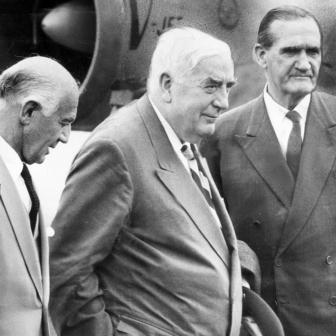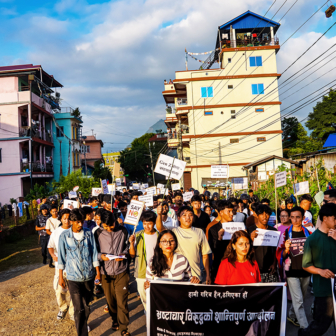“Something is fundamentally broken in the relationship between government and citizens,” writes Gabrielle Chan in her new book, Rusted Off: Why Country Australia Is Fed Up. Chan, a former political correspondent for the Guardian who has moved to the small town of Harden Murrumburrah in southern New South Wales, writes with knowledge of both sides of the divide. “There is Australia,” she says, “and there is the land of Parliamentalia… a castle surrounded by a moat.”
Recent events in Parliamentalia, which Chan could hardly have anticipated at the time of writing, provided a grotesque illustration of her theme. Amid the voices that dominate the airwaves, striving to shout each other down and cut each other off, how are we to hear the voices of the people they are supposed to represent? For Hugh Martin, head of distribution for the ABC’s regional and local division, this is a question of central importance.
Martin was an early convert to the digital revolution in news media. From the mid nineties, he was convinced of its “phenomenal” potential as a means of promoting audience engagement and gathering stories from regional and remote locations. Before joining the ABC, he had worked as an online editor for the Age and then spent six years setting up the digital arm of APN News and Media in regional New South Wales and Queensland.
With his metropolitan background, he found himself on a steep learning curve, he says, especially in Queensland, where the concentration of population and resources outside the major cities and strong local cultures created different ground rules for communication. “You can’t do business on the phone,” he says. “You have to go and sit with people, talk to them and understand what their concerns are.” In his current role, presiding over the Connecting Communities project, which involves an expansion of ABC regional operations through forty-eight bureaus across the country, he sees the work of communication as very much a two-way process.
“One of the things we need to do is articulate the value of public broadcasting for Australians in the twenty-first century,” he says. “A lot was done to address what it was for the later twentieth century, but the environment has changed.”
When ABC managing director Michelle Guthrie spoke about the lift in regional coverage at a Friends of the ABC dinner last year, she affirmed her commitment to maintaining the role of the national broadcaster as “Australia’s most important cultural institution” and a vital link between past, present and future.
One of the project’s most interesting and genuinely transformative aspects is its rethinking of the temporal frameworks of broadcasting. Places distant from the capital cities also allow for some distance from the tyranny of the twenty-four-hour news cycle, with its insatiable appetite for “breaking news.” Past, present and future are deeply interwoven.
The expansion itself has been implemented with some speed. Since the middle of last year, Martin has been involved in appointing staff to eighty new positions. Sixteen of the larger bureaus now have their own dedicated chief of staff, formerly a role combined with program-making responsibilities. They act as the editorial head of the local office, fielding the range of news coming in, listing stories for the state news desk and serving as representatives of the ABC in their communities.
Where regional stations were once seen as training grounds and stepping stones for journalists and producers, the new staff have been chosen with the expectation that they will make their careers locally. Being there for the long haul makes possible a different approach to news-gathering, drawing on deeper familiarities with a place and its people, tapping into “what lives under the surface of communities.”
This “slow news” experiment is in its early stages, Martin stresses, and the groundwork takes some time to establish. With funds to send journalists to remoter communities whose stories can’t be told on a fly-in-fly-out basis, he found that higher levels of trust were called for. In one case, the mayor of an Aboriginal town was uneasy about the proposal to send a reporter in for a ten-day residence — not surprising from a historical and political point of view, as Martin says.
It’s a question of how the ABC can go about winning trust, convincing community leaders that the aim is not to make invasive raids for news and information but to give voice to people who might not otherwise be heard. That means working through land councils and other peak bodies who might help build trusting relationships. “It struck me as a conversation that had never happened before. We don’t spend time revisiting stories, trying to do more considered and thoughtful coverage.”
But might this lead to some serious ethical dilemmas? Isolated communities can have ugly problems, and journalists are not necessarily the best people to help in a crisis. What may be a chronic and deeply distressing situation for residents may have nothing more than “breaking news” value for national audiences. I pushed Martin on this question. Did he envisage having to make some tricky judgements about what might be in the best interests of the local people and what might be regarded as “in the public interest”?
It’s important to distinguish between what is in the public interest and what is interesting to the public, he responded, citing the model of Back Roads, where reporters are free of the “public interest” imperative dominating news reportage and can adapt their focus to accord with local perspectives and concerns. In some cases, the interests of the community and those of a news organisation converge quite easily, providing that attention can be trained on a situation in a way that may assist in its resolution.
Martin gives the example of a residents’ campaign to keep the police station open in Alpurrurulam, west of Mount Isa. The police presence had reduced problems of violence associated with alcohol abuse in the township, a dry community in which the elders have struggled to make long-term gains in social wellbeing. In video journalist Lucy Murray’s report, the voices of the elders come through, and it is their concerns that frame the narrative. But wider issues are also covered. Alpurrurulam was one of eighteen remote locations where temporary police posts were established as part of the Northern Territory intervention. Plans to shift to a “remote patrol model” make sense in terms of police logistics and resourcing, but the human impact needs to be recognised.
Larger regional towns generate other kinds of controversy that also call for nuanced ethical judgement. Here, Martin is interested in the relationship between councils and residents. “I think local government is potentially a great power for good,” he says. “It is hugely important in people’s lives, but councils don’t always attract the best representatives. Perhaps the ABC can be a conduit for community ideas and questions that may not be getting through to councils.” He is participating in a Melbourne University research project developing the Australian National Development Index, which documents the aspirations Australians have for themselves, their communities and their country. “With all our radio stations across the country, we can be talking about the issues this project wants to cover. It tends to be the loudest voices that get heard, but there are lots of quieter voices that have really important things to say.”
Some of the regional bureaus are experimenting with a “community commissioning” approach to storytelling. “Simply put,” Martin says, “it’s a way of asking the audience what stories they want to see covered, voting for the most popular idea, and then putting a reporter to work alongside the person who proposed it.” A recent suite of stories from the Kimberley illustrates the diversity of ways in which people interest themselves in the places and landscapes they call home. There are tales of a cache of diamonds lost in the outback during the second world war, of the curious migration of boab trees from Madagascar to the Kimberley, and of how planetary movements create the massive tidal influxes in Talbot Bay.
Martin envisages future changes in the ABC’s role not in technological terms but “as a positive influence in Australian social and democratic life.”
“It’s worth a shot,” he reflects, “because so many other things don’t seem to be working. I’ve always tried to take calculated risks with a view to getting something achieved — new types of audience content, new forms, new ways of telling stories. That’s our opportunity.”
Martin’s opportunity may only push at the edges of the massive communications divide that is the subject of Gabrielle Chan’s book, but cultural change happens through a confluence of energy from many directions. “Localism” is an agenda too easily derailed under the steerage of those who occupy Parliamentalia and whose idea of acknowledging the great wide land they govern is to wear it as an emblem on their lapel pins. If the future of the nation can be wrested from their control, who knows what transformative changes might occur? •




